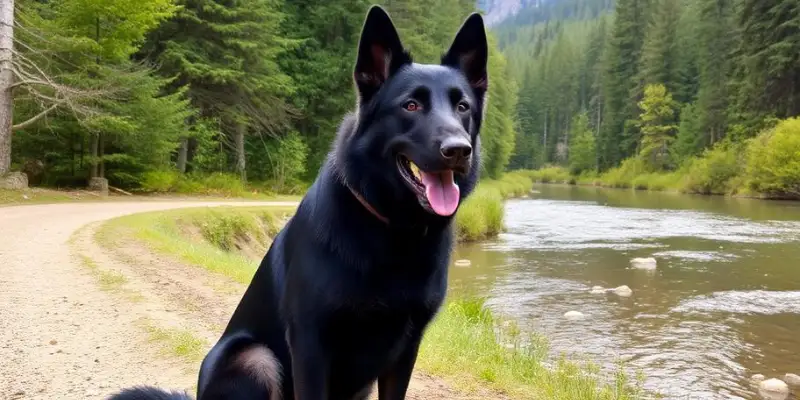Exploring the Depths of Black Sable German Shepherds
Updated: August 10, 2024
30
The German Shepherd is a renowned breed known for its intelligence, versatility, and loyalty. The black sable German Shepherd is a unique and captivating variant among its various colorations. This article delves into the characteristics, genetics, and breeding practices associated with black sable German Shepherds, providing an in-depth understanding of this fascinating breed.
What is a Black Sable German Shepherd?
A black sable German Shepherd is a variation of the standard German Shepherd with a distinct coat pattern. “sable” refers to a specific coloration where each hair is multi-colored, typically black-tipped with a lighter base. This pattern is pronounced in black sable German Shepherds, giving the dog a darker, more shadowed appearance compared to other sable variants.

Black Sable German Shepherd Color Variations
Within the black sable category, there can be variations in the intensity of the coloration. Some black sable German Shepherds may have a predominantly black coat with subtle lighter shades, while others may exhibit a more balanced mix of black and sable. This variation adds to the uniqueness and allure of the black sable German Shepherd.
Are Black Sable German Shepherds Rare?
Rarity Analysis of Black Sable German Shepherds
Black sable German Shepherds are considered relatively rare compared to more common color variations like black and tan. This rarity can be attributed to specific genetic factors and the selective breeding practices required to produce this coloration.
Contributing Factors
Several factors contribute to the rarity of black sable German Shepherds:
- Genetics: The black sable coloration results from specific genetic combinations less common in the broader German Shepherd population.
- Selective Breeding: Breeders specializing in producing black sable German Shepherds must employ meticulous breeding strategies to ensure the desired coloration, making these dogs less prevalent.
Can a Sable German Shepherd Parent Be Black and Tan?
Sable German Shepherd Genetics and Color Inheritance
The coloration of German Shepherds is determined by multiple genes interacting in complex ways. A sable German Shepherd can carry genes for other color variations, including black and tan. Therefore, a sable parent can produce black and tan offspring if they carry the necessary recessive genes.
Possibility of Sable Parents Producing Black and Tan Offspring
While uncommon, a sable German Shepherd can produce black and tan puppies if both parents carry the recessive black and tan genes. This genetic diversity is a testament to the rich and varied heritage of the German Shepherd breed.

How to Breed a Black Sable German Shepherd
Breeding Practices
To breed black sable German Shepherds, breeders must carefully select parent dogs that carry the genes for this specific coloration. Here are some key practices:
| Breeding Strategy | Description |
|---|---|
| Pedigree Analysis | Review lineage of potential breeding pairs to identify those with a history of producing black sable offspring |
| Genetic Testing | Conduct genetic tests to confirm presence of sable and black genes in breeding dogs |
| Selective Pairing | Pair dogs with complementary genetic profiles to increase likelihood of producing black sable puppies |
Tips for Breeders
- Health Prioritization: Ensure breeding pairs are healthy and free from hereditary conditions.
- Ethical Practices: Maintain ethical breeding practices to promote the overall well-being of the dogs.
- Knowledge and Experience: Continuously educate oneself on canine genetics and breeding techniques to achieve desired outcomes.
Black and Sable German Shepherd Puppies for Sale
Finding Puppies
Finding black and sable German Shepherd puppies requires research and patience. Potential buyers should:
| Step | Description |
|---|---|
| Research Reputable Breeders | Look for breeders with a proven track record of producing healthy, well-socialized puppies |
| Visit Breeding Facilities | Personally visit breeding facilities to ensure high standards of care and hygiene |
| Ask for Health Clearances | Request health clearances and genetic test results for parents and puppies |
Considerations for Buyers
- Cost: Black sable German Shepherds can be more expensive due to their rarity and the specialized breeding required.
- Commitment: Owning a German Shepherd, especially one with unique coloration, requires a long-term commitment to training, exercise, and care.
Black and Red Sable German Shepherd
Comparison of Coloration in Black and Red Sable
The black sable and red sable German Shepherds exhibit the sable coloration pattern but with different base colors. Black sable dogs have a darker, more shadowed appearance, while red sable dogs have a rich, reddish hue contrasting with black-tipped hairs.
German Sable Differences in Appearance
The primary difference lies in the base color. Red sable German Shepherds have a warmer, more vibrant coat, while black sable German Shepherds appear darker and more intense. Both variations are striking and add to the breed’s visual diversity.
Can Two Black and Tan German Shepherds Produce a Sable?
Genetic Possibilities
Two black and tan German Shepherds can produce sable offspring if they both carry the recessive sable gene. While rare, this scenario is genetically possible and illustrates the complex inheritance patterns in German Shepherds.
Likelihood of Sable Offspring
While it is less common, the likelihood of two black and tan parents producing a sable puppy depends on their genetic makeup. Breeders must understand these genetic principles to anticipate and achieve desired color variations.
What Makes a Black Sable German Shepherd Unique?
Specific Traits and Characteristics
Black sable German Shepherds possess several unique traits that set them apart:
| Characteristics | Description |
|---|---|
| Distinctive Appearance | Dark, multi-colored coat, striking and memorable look |
| Versatility | Excel in various roles: working, service, companionship |
| Temperament | Loyal, intelligent, protective, excellent family pets and working dogs |
Distinctive Qualities
The combination of their unique coloration and classic German Shepherd traits makes black sable German Shepherds a prized variant for enthusiasts and breeders alike.
Conclusion
The black sable German Shepherd is a captivating and unique variation of the German Shepherd breed. This variant stands out in dog breeds with its distinctive coloration, complex genetics, and the dedicated breeding practices required to produce it. Whether you are a potential owner or a breeder, understanding the nuances of the black sable German Shepherd adds to the appreciation of this remarkable dog.
FAQs
What is a black sable German Shepherd?
A black sable German Shepherd is a unique color variation of the German Shepherd breed. They have a black coat with sable markings, giving them a striking appearance.
Are black sable German Shepherds rare?
Yes, black sable German Shepherds are rare compared to other color variations. Their striking coloration and markings make them highly sought after by enthusiasts.
Can a sable German Shepherd’s parents be black and tan?
Yes, a sable German Shepherd can have black and tan parents. The genetics of the parents can influence the coloration of the offspring.
How do you breed a black sable German Shepherd?
Breeding a black sable German Shepherd involves carefully selecting parents with the desired color genes. Working with a reputable breeder who understands color genetics can help achieve the desired outcome.
Can two black and tan German Shepherds produce a sable?
Yes, two black and tan German Shepherds can produce a sable puppy. The parents’ color genetics can result in a variety of color combinations in their offspring.
What makes a black sable German Shepherd?
A black sable German Shepherd has a black base coat with sable markings, typically a lighter shade than the black coat. This combination creates a unique and eye-catching appearance.
Please Write Your Comments